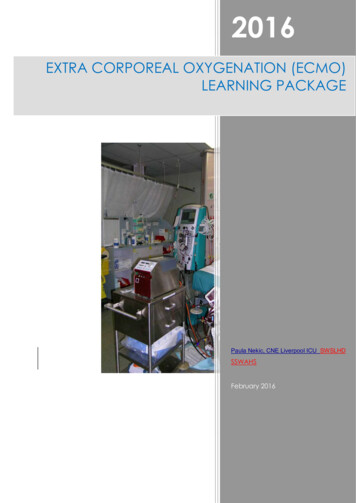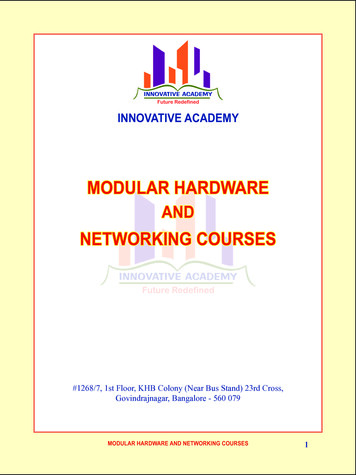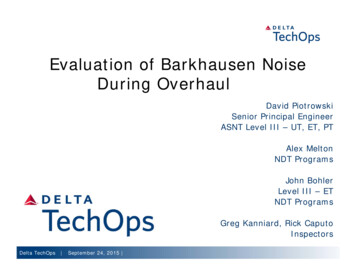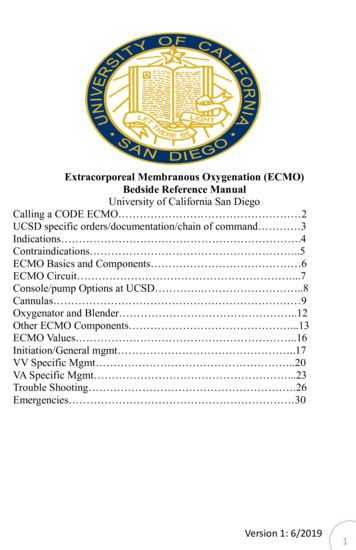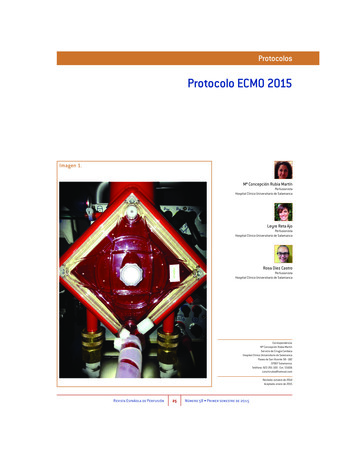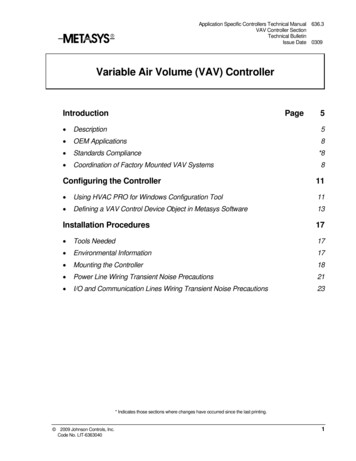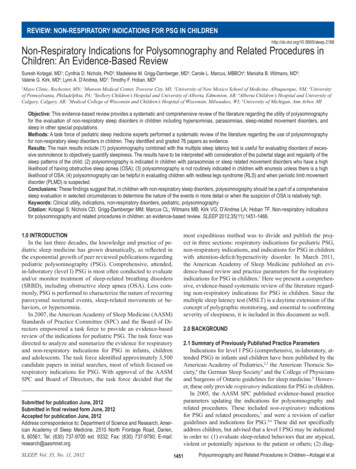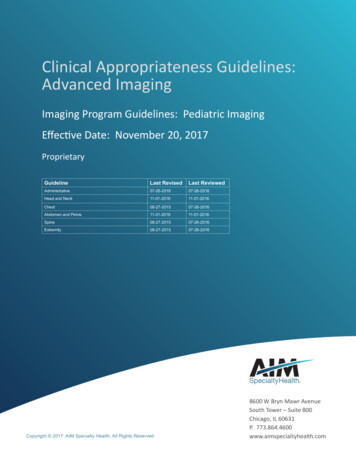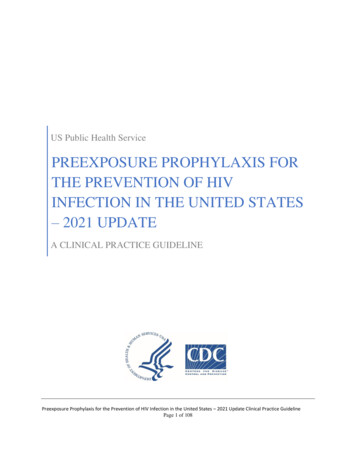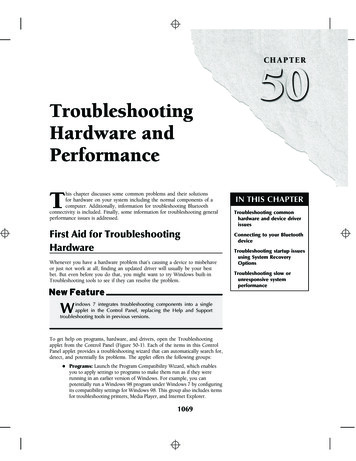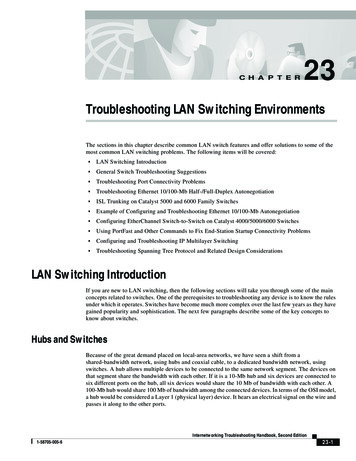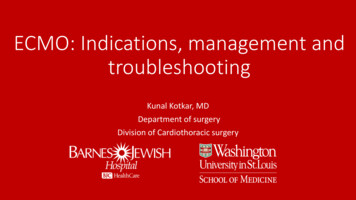
Transcription
ECMO: Indications, management andtroubleshootingKunal Kotkar, MDDepartment of surgeryDivision of Cardiothoracic surgery
ECMO ECLS is the use of mechanical devices to temporarily (days to months)support heart or lung function (partially or totally) duringcardiopulmonary failure, leading to organ recovery or replacement Evolution from cardiopulmonary bypassDepartment of Surgery
ECMO Cannulation140120Cannulated at OSHCannulated in-house100N 123N 102N 90480020911386N 289N 1018N 5106040N ent of Surgery
IndicationsRespiratory failure ALI/ARDS Aspiration Pneumonia Asthma Post lung transplant Lung contusionCardiac Failure Acute coronary syndrome Myocarditis Post cardiac arrest Pulmonary embolus Drug overdose Post cardiac surgery Bridge to transplant Post heart transplantDepartment of Surgery
Indication: Clinical condition Circulatory failure (CI 2.2) Severe acidosis (elevated lactate) Other organ damage(Liver enzymes, creatinine) Maxed out inotropic/vasopressor support Epi 0.2mcg/kg/min, Norepi 0.2 mcg/kg/min etc Worsening ventilator setup, prone, bilevel, FIO2 90%. Unable to come off CPB Pt is on temporary devices(Impella, IABP etc)Department of Surgery
Current Pharmacology & DevicesInotropesIABPECMOTandemHeartImpellaLVAD 0.50.52-63.52.5 - 5.03-6Coronary Perfusion -- LVEDP ------ Limb ischemiaN.A N.ABleedingN.A / AdvantagesFlow (L/min.)LimitationsArrhythmiaStrokeCostDepartment of Surgery
Indications for ECLS in Adult respiratory failure:1.In hypoxic respiratory failure due to any cause (primary orsecondary) ECLS should be considered when the risk of mortality is50% or greater, and is indicated when the risk of mortality is 80% orgreater.a. 50% mortality risk is associated with a PaO2/FiO2 150on FiO2 90% and/or Murray score 2-3.b. 80% mortality risk is associated with a PaO2/FiO2 100on FiO2 90% and/or Murray score 3-4 despite optimal care for6 hours or more.2.CO2 retention on mechanical ventilation despite high Pplat ( 30 cmH2O)3.Severe air leak syndromes4.Need for intubation in a patient on lung transplant list5.Immediate cardiac or respiratory collapse (PE, blocked airway,unresponsive to optimal care)ELSO adult respiratory failure supplement to the ELSO general guidelines 2013Department of Surgery
NIH trial 1979 90 patients 48 MV 42 MV ECMO 8 survivors. 4 in each group. Conclusion: no mortality benefit.Department of Surgery
Lancet 2009 180 pts, age 18-65 years, Murray score 3 or pH 7.2 Randomization to ECMO vs Conventional Ventilation Exclusion: peak pressures 30Department of Surgery
Department of Surgery
63% ECMO referral arm 47% ConventionalDepartment of Surgery
Contraindication : Adult respiratory failure:There are no absolute contraindications to ECLS, as each patient isconsidered individually with respect to risks and benefits. There areconditions, however, that are associated with a poor outcome despiteECLS, and can be considered relative contraindications1. Mechanical ventilation at high settings (FiO2 .9, P-plat 30)for 7 days or more2. Major pharmacologic immunosuppression(absolute neutrophil count 400/mm3)3. CNS hemorrhage that is recent or expanding4. Non recoverable co-morbidity such as major CNS damage orterminal malignancy5. Age: no specific age contraindication but consider increasing riskwith increasing ageELSO adult respiratory failure supplement to the ELSO general guidelines 2013Department of Surgery
ContraindicationsAbsolute Contraindications Severe irreversible neurologicalcondition Encephalopathy Cirrhosis with ascites History of variceal bleeding Moderate-severe chronic lungdisease Terminal malignancyAbsolute Contraindications toVeno-Venous ECMO Severe left ventricular failure EF 25% Cardiac arrestAbsolute Contraindications toVeno-Arterial ECMO Aortic dissection Severe aortic regurgitationDepartment of Surgery
ContraindicationsRelative Contraindications Age 65 Multiple trauma withuncontrolled hemorrhage Multi-organ failureRelative Contraindication to VenoArterial ECMO Severe peripheral vasculardiseaseRelative Contraindication to VenoVenous ECMO High pressure / high FiO2 IPPVfor 1 weekDepartment of Surgery
Department of Surgery
Department of Surgery
Department of Surgery
Factors influencing ECMO outcome Age Not a strict cutoff Good expected medium-to-long term outcome withoutacute illness i.e., free of condition with high near-term mortality Early application of lung protective ventilation Early application of adjunctive strategies Early referral for consideration of ECMODepartment of Surgery
Timing of ECMO referral In an appropriate candidate: PF 50 for 3 hours despite ventilator optimization and useof adjunctive measures OR PF 100 for 6 hours despite attempted optimization OR pH 7.20 with predominantly respiratory component despiteattempted optimization Early referral is key to improving outcomesDepartment of Surgery
Department of Surgery
ECLS(ECMO) CircuitDepartment of Surgery
Types Veno –arterial ( VA) Veno- Venous (VV) Veno-arterial-venous (VAV)Department of Surgery
Department of Surgery
Venoarterial ECMOVenovenous ECMOHigher PaO2 is achievedLower PaO2 is achievedLower perfusion rates are neededHigher perfusion rates are neededBypasses pulmonary circulationMaintains pulmonary blood flowDecreases pulmonary arterypressureIncreases mixed venous PO2Provides cardiac support to assistsystemic circulationDoes not provide cardiac support toassist systemic circulationRequires arterial cannulationRequires only venous cannulationDepartment of Surgery
Types of ECMOSVCIVCRA RVPAVeno-VenousLungsLALVAODepartment of Surgery
Types of ECMOSVCIVCRA RVPARA-PA (RVAD)LungsLALVAODepartment of Surgery
Types of ECMOSVCIVCRA RVPALungsLALVVeno-Arterial(Central or Peripheral)AODepartment of Surgery
Types of ECMOSVCIVCRA RVPALungsLALVAOLV or LA – Ao(LVAD)Department of Surgery
Types of ECMOSVCIVCRA RVPARA-PA (RVAD)LungsLALVAOLV or LA – Ao(LVAD)Department of Surgery
ECMO Circuit Pump Oxygenator Cannulae Tubing Gas / Heat exchanger No Reservoir No suckersDepartment of Surgery
Pump Types Roller Pumps Centrifugal pumpsDepartment of Surgery
Department of Surgery
OxygenatorHollow fiber PMP oxygenator extremely efficient at gas exchange minimal plasma leakage; have relatively low resistance to blood flow Easy to prime; well suited for use with centrifugal bloodpumps Integrated heat exchange deviceEg. Quadrox-iD (Maquet, Hirrlingen, Germany), Hilite LT (Medos, Stolberg, Germany), Lilliput 2 (Sorin, Mirandola Modena, Italy) Biocube (Nipro, Osaka, Japan.)Department of Surgery
CannulaeDepartment of Surgery
Department of Surgery
Keys for successful femoral cannulation Avoid femoral cannulations for PVD, small vessels (U/S), Obese ptsU/S guide, avoid back wall puncture, avoid SFA punctureStiff wireLarge skin cut, Good dilators, hold the wire tight when you push a dilatorTEE/fluoroscopy guiding, xray to avoid RV perforation or aortic dissectionSecure the distal superficial femoral artery perfusion before femoral cannulation ifpossible/needed Think about which side you cannulate, artery and vein Sewing a graft on, most likely hyperperfuse distally. Place the venous cannula on the contralateral side If removing arterial cannula later to move on to central, cannulate artery only for the later repair sx. Venous cannulation may be better on the right, but no clinical difference. Arterial first, then venous Leave obturators in Confirm No clot in the cannulas before initiate ECMODepartment of Surgery
Central cannulation Over 20 Fr. Aortic cannulation 32-36 Fr Venous cannula to the RA Tunnel through the upper abdomen Close the chest with cannulas in Minimally invasive aortic cannulationsanterior thoracotomy for arterial cannulationPeripheral venous cannulationDepartment of Surgery
Peripheral, Central or HybridPeripheral (groin)Central (aorta)Hybrid (axillary)LocationBedsideORORTargetSmall vesselDistal mal-perfusionPossible graft utilizationand distal hyperemiaAortic cannulationSmall-MediumvesselLess diseasedGraft utilization anddistal hyperemiaFlowReverse flow in thedescending aortic archAntegrade brainperfusionAntegrade brainperfusionApproachNo sternotomySternotomyMini-thoracotomyNo sternotomyBleedingGraft bleedingBleeding related tosternotomyGraft bleedingDepartment of Surgery
Peripheral, Central or Hybrid No evidence It appears to be reasonable if you can central/Hybrid cannulation if Patient condition Logistics, OR available Hybrid and ambulatory ECMO Avoid limb ischemia Small size cannula Distal limb perfusionDepartment of Surgery
Limb ischemia higher mortality? Distal perfusion cannula reduces limb ischemiaDepartment of Surgery
Department of Surgery
SFA perfusion cannulaRoutine, percutaneous insertionSFA first, U/S6F 11cm Super Arrow-flex catheterOpen repair for decannulationDepartment of Surgery
Distal perfusion cannulaDepartment of Surgery
Dual lumen cannulaDepartment of Surgery
Tubing Medical grade polyvinyl chloride tubing is universally used flexible, compatible with blood, inert, nontoxic, smooth, transparent, and resistant to kinking andcollapse Heat sterilised. Bioactive coating of artificial surfaces with heparin or albuminDepartment of Surgery
Mixer/blenderDepartment of Surgery
LV VENT with VA ECMOOptions No ventIABPPercutaneous VAD (Impella, PHP)Atrial septostomy (Tandem Heart)Surgical LV vent LV apex LA to LV PA ventDepartment of Surgery
IABP with ECMO Not clear survival benefit Lin 2016, Cheng 2015 Likely hemodynamical advantage Ma 2014, Madershahian 2011 IABP is in place already No need to remove unless LVEDP increase Heparin/coagulopathy Limb ischemia/bleedingDepartment of Surgery
Impella with ECMO Likely unload the LV with ECMO Cheng 2013, Guirgis 2015, Tepper 2016 Can be initiated in the cathlab Hemolysis Cardozo 2015, Sibbald 2012 Valvular issues Mitral valve leaflet injury Eftekhari2016 Aortic valve injury Distal limb ischemiaDepartment of Surgery
ECMO ImpellaHF.APS.P212 - Medical Aspects End StageHeart Failure: Transplantation and DeviceTherapies IV, Poster session AHA 2016Department of Surgery
Anticoagulation Initial small dose of heparin (2-5k), ACT 200 for cannulationsLeave obturators in until the last minute, cannulate arterial firstRun ECMO without heparin/bivalirudin (HIT) with clinical bleeding24 to 48 hours after ECMO initiation start 500-750u/hr of Heparin, then PTT60-90sec ACT Anti Xa POC TEG ROTEMDepartment of Surgery
WeaningNomagic! Bridge to RECOVERY or bridge to MCS, potentially heart transplant. Serial echocardiogram EF 30-40% with ECMO flow down to 1-2 L/m No valvular issues or ongoing ischemia Clinical observation Bedside weaning test, down to 1-2 L/mGood Pulsatility with inotropics/vasopressorsNeurologically intact, clear head CT scanRespiratory tolerable condition, bronchoscopy on ECMO, otherwise VVECMO Add other circulatory support IABP (Femoral or axillary) Impella (Femoral or axillary) LVAD/BIVAD for HTx or DTDepartment of Surgery
Decannulation No heparin and decannulate with solid confidence of heart recovery. ACT 200, clamp cannulas, disconnect tubings and recirculate theECMO circuit Volume, inotropic and mechanical support with TEE Auto transfusion via ECMO circuit IABP or impellaDepartment of Surgery
ECMO managementDepartment of Surgery
ECMO management Mechanical ventilation is continued during ECMO support Lung protective ventilation strategies PCO2 control through ECMO Cardiac resting by reduction of inotropes and pressors LV venting Maintenance of pulsatility- inotropes and IABPDepartment of Surgery
Department of Surgery
Complications Bleeding Cannulation siteChest tube insertion siteICHGI bleedRetroperitoneal, nasopharyngeal, airway. Thrombosis DVTCircuit thrombosis (hypercoagulable status)Oxygenator thrombosisStroke with debris in the arterial system Air emboli iatrogenic R- L shunt, central line air bubbles - Anoxic brain injury air suction to malpositioned venous cannula - circuit exchange Gas exchange, circuit issues Hypoxemia, cerebral ischemia Hypocapnea, cerebrovascular spasm Tube rupture or disconnection- lethal exsanguinationDepartment of Surgery
Department of Surgery
Department of Surgery
Department of Surgery
Ambulatory ECMO Increasing volumes of lung transplants and increasing number ofpatients added Mean waitlist mortality of 15.7% Mean waitlist time of 3.6 months Early outcomes of ECMO in waitlisted patients were poor However , ECMO as a bridge to lung tranplantation is now wellestablishedDepartment of Surgery
Issues with conventional ECMORationale(1) Upright patients who are ambulatory and socially interactive provide themost effective vehicle for clinical recovery or subsequent bridge totransplant.(2) No lung disease or pulmonary injury benefits from paralysis, sedation,and intubation with non physiological positive pressure ventilation. ventilator-associated pneumonias Barotrauma as a consequence of positive pressure ventilation Requirements of sedation and paralytics to facilitate permissivehypercapnea as a strategy to limit barotrauma profound deconditioning of both respiratory and skeletal muscle becauseof “ventilated, bed-bound” care.Department of Surgery
Techniques Multiple cannulation strategies are used to facilitate early extubationand ambulation Early deployment Use of Oxy- RVADsDepartment of Surgery
Department of Surgery
Department of Surgery
Department of Surgery
Department of Surgery
Department of Surgery
Department of Surgery
Department of Surgery
Department of Surgery
Department of Surgery
Our OutcomesDepartment of Surgery
ECMO patients in 2017-18Department of Surgery
ECMO patients in 2017-18Department of Surgery
Thank You
Department of Surgery ECMO Cannulation 28 51 86 78 93 92 113 0 0 4 8 9 9 10 0 20 40 60 80 100 120 140 2011 2012 2013 2014 2015 2016 2017 Cannulated at OSH Cannulated .
